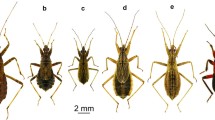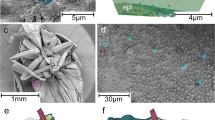Summary
The ultrastructure of trichobothria and normal mechanoreceptive bristles has been studied in Microcaeculus steineri delamarei. In spite of great differences in the outer appearance the inner structure of both kinds of sensilla is quite similar: In each case two dendrites are linked to the hair base by a system of fibrils. Therefore it may be suggested that two different directions may be distinguished by each sensillum. Apparently, the bristles may be bent in every direction, but at least the trichobothria show two favorite directions of bending. Certainly the oval shape of the hair base is the morphological reason for this pecularity. The fibrillar arrangement attaching the tubular bodies to the hair base deserves special interest concerning possible movements of the tubular bodies during the bending process of the sensory bristle. Some cytochemical studies are under investigation.
Zusammenfassung
An Microcaeculus steineri delamarei wurde die Feinstruktur der Trichobothrien und der normalen mechanorezeptiven Borsten untersucht. Trotz der großen Unterschiede in der äußeren Erscheinung ist der innere Bau beider Sensillentypen recht ähnlich: In jedem Falle stehen zwei Dendriten über ein fibrilläres System mit der Haarbasis in Verbindung. Es ist daher anzunehmen, daß these Sensillen jeweils zwei verschiedene Richtungen unterscheiden können. Obwohl die Sinneshaare aufgrund ihrer Aufhängung in alle Richtungen ausgelenkt werden konnen, sind wenigatens bei den Trichobothrien zwei bevorzugte Auslenkrichtungen zu beobachten. Wahrscheinlich ist die leicht ovale Form der Sinneshaarbasis für these Besonderheit ausschlaggebend. Das fibrilläre System, das die Tubularkörper mit der Haarbasis verbindet, erscheint von besonderem Interesse im Hinblick auf mögliche Bewegungen der Tubularkörper bei Haarauslenkung. Weitere cytochemische Untersuchungen sind im Gange.
Similar content being viewed by others
Literatur
Andersen, S. O., Weis-Fogh, T.: A rubberlike protein in Arthropod cuticle. Adv. Insect Physiol. 2, 1–65 (1964)
Aoki, J.: Soil mites climbing trees. Proc. 3. Int. Congr. Acarol., Prague (1971), p. 59–65. The Hague: Junk 1973
Axtell, R. C.: Tarsal sensory receptors of ticks. Proc. 4. Int. Congr. Acarol., Saalfelden (1974). Budapest: Akadémiai Kiadó (im Druck)
Barth, F. G.: Die Feinstruktur des Spinneninteguments. I. Die Cuticula des Laufbeins adulter häutungsferner Tiere (Cupiennius salei Keys.). Z. Zellforsch. 97, 137–159 (1969)
Barth, F. G.: Bauprinzipien und adaequater Reiz bei einem Mechanorezeptor. Verh. dtsch. zool. Ges. 66, 25–30 (1972)
Bischof, H.-J.: Die keulenformigen Sensillen auf den Cerci der Grille Gryllus bimaculatus als Schwererezeptoren. J. comp. Physiol. 98, 277–288 (1975)
Christian, U.: Zur Feinstruktur der Triehobothrien der Winkelspinne Tegenaria derhami (Scopoli). Cytobiol. 4, 172–185 (1971)
Christian, U.: Triehobothrien, ein Mechanorezeptor bei Spinnen. Verh. dtsch. zool. Ges. 66, 31–36 (1972)
Coineau, Y.: A propos de l'ceil antérieur du naso des Caeculides. Acarol. 12, 109–118 (1970)
Coineau, Y.: Éléments pour une monographic morphologique, écologique et biologique des Caeculides (Acariens). Mém. Mus. Nat. Hist. Nat. A 81, 1–299 (1974)
Foelix, R. F., Axtell, R. C.: Fine structure of the tarsal sensilla of the tick Amblyomma americanum L. Z. Zellforsch. 114, 22–37 (1971)
Foelix, R. F., Chu-Wang, I-Wu: The morphology of spider sensilla. I. Mechanoreceptors. Tiss. & Cell 5, 451–460 (1973)
Gaffal, K. P., Bassemir, U.: Vergleichende Untersuchungen modifizierter Cilienstrukturen in den Dendriten mechano- und chemorezeptiver Rezeptorzellen der Baumwollwanze Dysdercus und der Libelle Agrion. Protoplasma 82, 177–202 (1974)
Gaffal, K. P., Hansen, K.: Mechanorezeptive Strukturen der antennalen Haarsensillen der Baumwollwanze Dysdercus intermedius Dist. Z. Zellforsch. 132, 79–94 (1972)
Gnatzy, W., Schmidt, K.: Die Feinstruktur der Sinneshaare auf den Cerci von Gryllus bimaculatus Deg. (Saltatoria, Gryllidae). I. Faden- und Keulenhaare. Z. Zellforsch. 122, 190–209 (1971)
Görner, P.: A proposed transducing mechanism for a multiple-innervated mechanoreceptor (Trichobothrium) in spiders. Cold Spr. Harb. Symp. quant. Biol. 30, 69–73 (1965)
Görner, P., Andrews, P.: Triehobothrien, ein Ferntastsinnesorgan bei Webespinnen (Araneen). Z. vergl. Physiol. 64, 301–317 (1969)
Grandjean, F.: Les poils et les organs sensitifs portés par les pattes et le palpe chez les Oribates. Bull. Soc. zool. Fr. 60, 6–39 (1935)
Grandjean, F.: Le développement postlarvaire d'Anystis (Acarien). Mém. Mus. Nat. Hist. Nat. (N.S.) 18, 33–77 (1943)
Haupt, J.: Beitrag zur Kenntnis der Sinnesorgane von Symphylen: I. Elektronenmikroskopische Untersuchung des Trichobothriums von Scutigerelta immaculata Newport. Z. Zellforsch. 110, 588–599 (1970)
Haupt, J.: Ultrastruktur der Triehobothrien von Allopauropus (Pauropoda). Proc. 3. Int. Congr. Myriapodol., Hamburg (1975). Ent. Germ. (im Druck)
Hoffmann, C.: Bau und Funktion der Triehobothrien von Euscorpius carpathicus L. Z. vergl. Physiol. 54, 290–352 (1967)
McIver, S.: Structure of cuticular mechanoreceptors of Arthropods. Ann. Rev. Ent. 20, 381–397 (1975)
Nemetschek-Gander, H., Berg, G., Schiller, O.: Erfahrungen mit einer neuen Fixierungs- und Einbettungsmethode für die Routine-Histologie. Beitr. Path. 147, 201–206 (1972)
Nicklaus, R.: Die Erregung einzelner Fadenhaare von Periplaneta americana in Abhängigkeit von der Größe und Richtung der Auslenkung. Z. vergl. Physiol. 50, 331–362 (1965)
Nicklaus, R.: Zur Funktion der keulenförmigen Sensillen auf den Cerci der Grillen. Zool. Anz., Suppl. 32, 392–398 (1969)
Nicklaus, R.: Zur Richtcharakteristik der Fadenhaare von Periplaneta americana. Z. vergl. Physiol. 54, 434–437 (1967)
Satir, P.: Studies on cilia. J. Cell Biol. 26, 805–826 (1965)
Schenk, O.: Die antennalen Hautsinnesorgane einiger Lepidopteren und Hymenopteren mit besonderer Berücksichtigung der sexuellen Unterschiede. Zool. Jb. Anat. 17, 573–618 (1903)
Schwartzkopff, J.: Mechanoreception. In: The physiology of insecta, 2. ed., M. Rockstein, ed., vol. 2. New York-London: Academic Press 1974
Snodgrass, R. E.: The morphology of insect sense organs and the sensory nervous system. Smiths. misc. Coll. 77, 1–80 (1926)
Tarman, K.: Über Trichobothrien und Augen bei Oribatei. Zool. Anz. 167, 51–58 (1961)
Thurm, U.: An insect mechanoreceptor. I. Fine structure and adaequate stimulus. Cold Spr. Harb. Symp. quant. Biol. 30, 75–103 (1965)
Thurm, U., Stedtler, A., Foelix, R.: Reizwirksame Verformung der Terminalstrukturen eines Mechanorezeptors. Verh. dtsch. zool. Ges. 67, 37–41 (1974)
Vitzthum, H. Graf: Acarina. In: Bronns Klassen und Ordnungen des Tierreichs V, 4. Abt., 5. Buch. Leipzig: Akadem. Verlagsgesellschaft 1943
Wachmann, E., Haupt, J., Richter, S., Coineau, Y.: Die Medianaugen von Microcaeculus (Acari, Prostigmata, Caeculidae). Z. Morph. Tiere 79, 199–213 (1974)
Wharton, G. W., Parrish, W., Johnston, D. E.: Observations on the fine structure of the cuticle of the spiny rat mite, Laelaps echidnina (Acari, Mesostigmata). Acarol. 10, 206–214 (1968)
Author information
Authors and Affiliations
Additional information
Wir danken Herrn Rau, Zentraleinrichtung für Elektronenmikroskopie der TU Berlin, für die Durchführung der Arbeiten am Rasterelektronenmikroskop.
Rights and permissions
About this article
Cite this article
Haupt, J., Coineau, Y. Trichobothrien und tastborsten der milbe Microcaeculus (Acari, Prostigmata, Caeculidae). Z. Morph. Tiere 81, 305–322 (1975). https://doi.org/10.1007/BF00298490
Received:
Issue Date:
DOI: https://doi.org/10.1007/BF00298490




